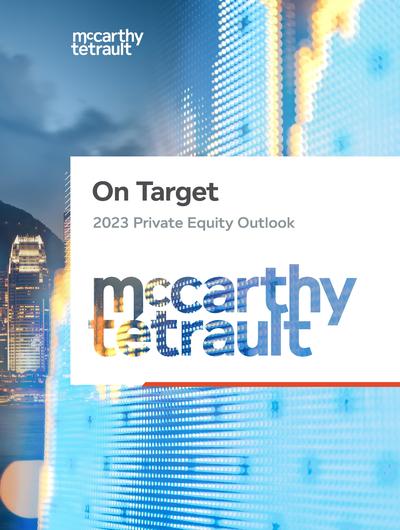Private Equity Outlook 2023 - Top Ten Takeaways
After the feverish pace of 2021, the Canadian private equity (PE) market cooled down significantly in 2022. Deal activity and deal values both suffered in comparison to the record highs of the previous year. Looking ahead, McCarthy Tétrault’s PE professionals weighed in with observations on 2022 and predictions on what investors and firms can expect for 2023.
Takeaway 1: A Cooler Market May Persist
Hoping to recover from a tumultuous year, PE firms may exercise more caution in 2023. Persistent inflation, rising interest rates and geopolitical events may cause PE firms to allocate capital more judiciously. It remains to be seen how Canadian companies will handle these challenges – and potential new ones – in the coming year. While PE-backed exits will likely continue their downward trend from 2022, add-on transactions may grow as firms continue to specialize and build industry-specific expertise.
Takeaway 2: The Energy Sector Dominates, with IT and B2B in the Periphery
The energy sector saw a significant increase in invested PE capital since 2021, despite a lower deal count. As of December 2022, C$7.2 billion of PE capital was invested in the energy sector, compared to C$1.45 billion in the prior year. As a distant runner-up, the information technology sector saw C$2.2 billion of PE capital invested – a 45% decrease from its 2021 figures. Meanwhile, the B2B sector - while leading all other sectors in overall deal count - saw a 77% decline in deal value from 2021.
Takeaway 3: The Insolvency Market is Poised to Ramp-Up
For distressed investments, quick execution and creative approaches will be rewarded. In sales and investment solicitation processes (SISP), which are often truncated, groups that are efficient in deploying due diligence teams and making decisions will have a key advantage over those who are not. However, since SISP can often face challenges in down markets, creative restructuring solutions should be reviewed. These may include traditional compromises, plans of arrangement, and a variety of insolvency tools.
Takeaway 4: For Lenders, Quality Beats Quantity
In 2023, the pace of acquisition financings have declined as lenders take a more cautious and prudent approach. After the red hot markets of 2020 and 2021, and parts of 2022, lenders are placing more emphasis on familiar sponsors and high quality credits. Interest coverage ratios and leverage ratios may come into greater focus, as lenders become mindful of limiting their exposure and preserving capital. Banks will also generally take a more deliberate, thorough approach to due diligence and credit approval processes to ensure their deals are structured appropriately for the market conditions and will allow more time for syndication processes to complete.
Takeaway 5: Continuation Funds Have Become Prevalent
Sponsors have caught on to the benefits of continuation funds. This trend continued in 2022 with sponsors increasingly using continuation funds as viable alternatives to traditional M&A and IPO exits given current market volatility, giving investors an option for liquidity while allowing sponsors to continue to hold their “crown jewel” assets that may have further potential for growth. In 2022, secondaries funds continued to raise capital at historic rates, led by large funds from traditional secondaries players and many new entrants in the space – including established managed launching secondaries strategies. Demand for continuation funds was fueled by these secondaries funds looking to deploy their increased amounts of capital. This demand, combined with the benefits to sponsors, suggests that continuation funds will continue to be a prominent feature of the private funds landscape in 2023 and beyond.
Takeaway 6: The CRA Clarifies its Position on Loans to Limited Partners
The CRA has provided long-awaited guidance on the conditions that must be met for CRA to treat loans from limited partnerships to their limited partners as loans and not distributions, but uncertainty still looms. These conditions include that loans must (1) be in respect of profits and not represent a return of capital, and (2) be made primarily for the purpose of mitigating the deemed capital gain (and potential double taxation) issue that can result from a distribution of profits in the same fiscal period as the profits are earned. While this guidance will be welcome to most limited partnerships, the CRA’s conditions provide for a narrow administrative exception that will not be available in all circumstances. PE funds should consider whether any changes are required to their partnership agreements to facilitate the making of loans that fit within the CRA’s guidelines.
Takeaway 7: Proposed Amendments May Impose New Withholding Tax Obligations
These proposed amendments to the Income Tax Act (Canada) could impact foreign PE funds with Canadian investors – even when the fund has no Canadian investments. The Income Tax Act (Canada) imposes a 25% withholding tax on certain amounts paid by Canadian residents to non-Canadian residents. Currently, a partnership is deemed to be a Canadian resident for this purpose to the extent that such an amount is deductible in computing the partnership’s income or loss from a source in Canada, however the proposed rules would deem the partnership to be a Canadian resident to the extent that the amount is deductible in computing the share of the partnership’s income or loss that is allocable to Canadian residents (and certain non-residents subject to Canadian income tax). This potential change could cause foreign funds to pass the associated costs to Canadian investors, or even impact the circumstances in which foreign funds will admit Canadian investors.
Takeaway 8: Greenwashing – an Unsustainable Practice
Even for voluntary sustainability-related disclosure, PE firms should be mindful of the potential legal liability against companies and their directors and officers. Greenwashing allegations, such as claims of inaccurate or misleading statements on corporate ESG activities or commitments, may give rise to civil litigation, class actions and regulatory proceedings. The lack of a mandatory global standard for sustainability-related disclosure has created a state of flux over what must be included. In Canada and elsewhere, this vacuum has spurred a number of well-resourced and coordinated complaints to competition and securities regulators relating to sustainability-related disclosures.
Takeaway 9: PE Firms Will Continue to be Significant Players in the Take-Private Market
Falling public valuations and the pressures of running a public company present an opportunity for PE firms to lure companies away from the public markets. PE buyers can also offer management teams a rollover component to the transaction, allowing them to remain invested in the target as minority shareholders. These benefits, among others, often allow PE firms to offer lower premiums to target shareholders. When these deals are struck, they are virtually always done through a court-approved plan of arrangement structure.
Takeaway 10: Despite Uncertainty, PE Firms Should be Proactive
While it’s not always clear how to respond to changes in the macroeconomic environment, regulation and public opinion, PE firms can take proactive steps to get ahead of these changes. For instance, a fund may benefit from revisiting its limited partnership agreements to ensure that any provisions regarding loans to limited partners are aligned with the CRA’s conditions. It may also wish to scrutinize its ESG strategy to ensure that any stated goals are backed by actionable, robust plans.
Discover how our national Private Equity Group can guide you through 2023 by contacting our presenters below or by reading our latest report, On Target: 2023 Private Equity Outlook.
Couldn’t join the webinar? We have you covered. View the recording and catch all the insights.









